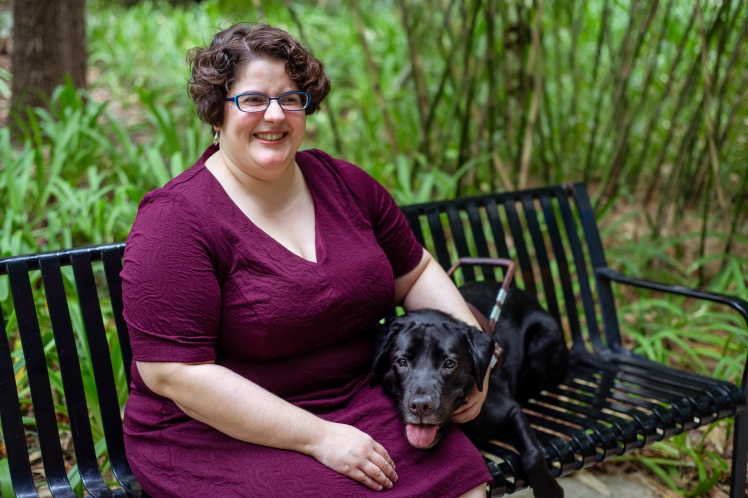For publications and speaking opportunities, I’m often asked for a professional photo. Because I can’t take my own selfies, I’ve had to rely on the same couple of photos – either the product of a professional event or a kind friend with the patience to photograph me. Often these pictures are years out of date.
As a blind woman, I am rarely comfortable having my picture taken. I am extremely light-sensitive, which means a necessary flash leaves me squinting in pain. I can’t visually locate the photographer just before the click — whether it’s a professional with a tripod or a friend with a selfie stick. And the need for instant immortalizing of moments never gives me enough time to learn where I should look or get in position. Even in formal settings, most photographers don’t know how to guide me quickly. Despite these visual challenges, I can see well enough to be unhappy with the photos of myself that result. So the inevitable picture-taking at weddings, holidays, and life events fils me with anxiety: I feel I always need more time, and I don’t know how to communicate what I need quickly. The rest of the group is ready and I’m still asking, “Where do I look?” People can’t answer and hold their smiles at the same time.
I know I can photograph well, but I require more time and attention than the average sighted person. I need the photographer to count down to the flash — a trick I discovered during an exceptional portrait session I had in high school. Knowing that I was unhappy with the rushed photos we were required to take for the yearbook, my mom insisted on taking me for glamor shots, and over the course of three hours, the inventive and courteous photo team helped me figure out my process. If the person with the camera counts to three right before the flash, I can keep my eyes closed up to the moment when the photo is taken: I open my eyes as the camera flashes and I don’t have time to squint. This trick is a pain-free option that helps me get photos I enjoy.
After relying on an outdated photo for several events this year, I decided it was time to try another professional session. I contacted Chelsea Whiteman, a friend and former colleague who runs her own photography business. I explained that I needed professional portraits for my writing gigs, and I explained my apprehensions and challenges. Chelsea was eager to work with me — but she reminded me that her style is different from traditional studio portraits. The pictures would not look like updated yearbook photos or department store holiday prints. I had no idea how her perspective would translate for photos of me, but I wanted to find out.
Chelsea helped me choose a location and time. I explained my sensitivity to light, and she suggested that we take our pictures in an outdoor setting at dusk. She also recommended that I wear a solid color as patterned fabrics did not photograph well. I appreciated the advice. I chose a solid dress and a patterned scarf that could be added for variety.
I also explained my insecurities about not being prepped for each shot. I asked Chelsea to be very specific in how I should stand and angle my body as well as where I should look. I asked for some head shots, some full-length portraits, and some cute photos with York. Chelsea took all this information on board and prepared for our session.

On the evening of our photos, we were accompanied by Chelsea’s partner Dylan and my friend Michele. Dylan assisted Chelsea, and Michele held York while I was taking solo photos. Michele was later called upon to make very convincing cat noises so York would look at the camera.
Chelsea had chosen the session time well. I was able to take all of our photos without my sunglasses. We moved throughout several green areas, and most of them worked well for our photos. Sometimes I had to say, “I think the light is too bright here,” but often, Chelsea picked up on my discomfort before I said anything. She would say, “I think you’re not going to be comfortable here, so let’s just move on.”
For each photo, Chelsea observed how I was standing naturally before making any adjustments. She invited me to sit down, look up, look over my shoulder, put my hand on my hip, tie or untie my scarf – all to help me feel comfortable and convey a sense of liveliness in the photo. Sometimes she climbed up on the bench beside me and took the photo from above. At every stage of the session, she provided a running commentary on how the shots looked from her side and what I was doing well.
As the session progressed, I felt increasingly confident and photogenic. I felt that I really had something to offer the camera and that these photos would be a complement to my professional presence. Chelsea was clearly enjoying the session, and she easily worked around my visual challenges. Her professional calm and skill reassured me that my visual circumstances would not get in the way of a good photo.

When I am happy with a photo of myself, it is not just because I like the way I look. Chelsea’s photos remind me that, in the hands of a skilled and conscientious photographer, the time and effort I require will pay off.
The pictures you included in your article prove that your friend Chelsea is an excellent professional photographer. Her photos of you are lively, engaging and appear to be quite natural. Kudos to Chelsea for working so well with you! Lois